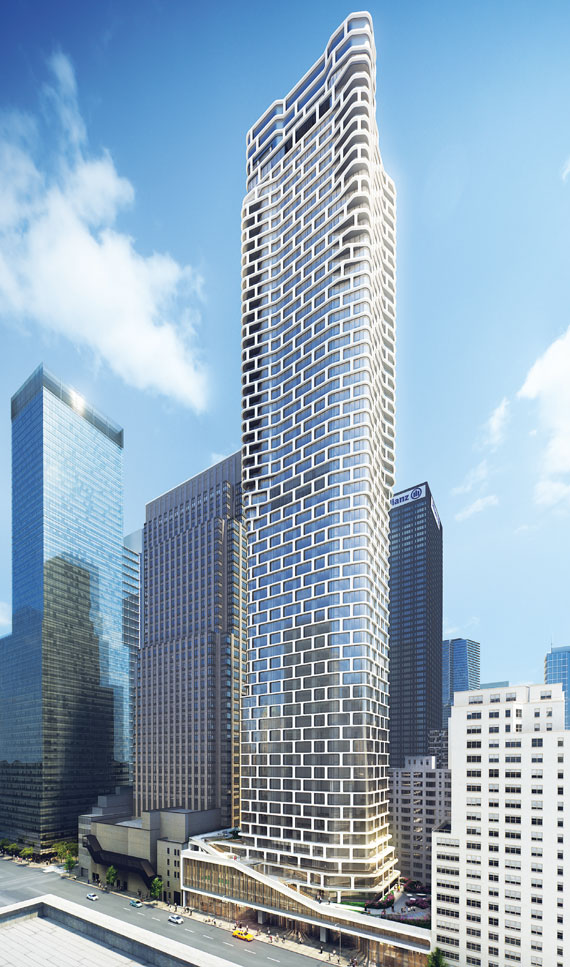Trending
A mini-revolution in Midtown
CetraRuddy tower will bring distinction to drab neighborhood

The designers over at CetraRuddy are nothing if not pluralistic.
Their latest project, an irregularly shaped tower at 242 West 53rd Street that looks like a mod pepper shaker draped in postmodern lace, is worlds apart from what is perhaps their best and best-known achievement to date, One Madison.
That building, completed in 2010, was initially reviled for the audacity with which it seemed to dominate Madison Square Park. By now, however, New Yorkers, many of whom did not initially appreciate the stern geometric rectitude of its mostly modernist idiom, have come around, and it is a welcome part of the Manhattan cityscape.
At 242 West 53rd Street, however, the same architectural firm has channeled a spirit that is more mod than modern, with elements of postmodern techno design thrown in for good measure, something rare, if not unprecedented, for the firm.
Developed by Algin Management, the new building will rise on the former home of the fabled Roseland Ballroom, which stood in the spot for more than half a century, and welcomed to its stage stars from Elvis Presley to Lady Gaga. The new arrival will reach about 60 stories, and will contain 426 one- and two-bedroom condo units, with two duplexes. The duplexes are among a trio of penthouses on the 58th floor. The plans also call for an 86-car garage and two swimming pools. There will be retail at street level and multiple outdoor terraces, including two that are tucked in on the third floor, between the base of the building and the point from which the tower springs upward.
CetraRuddy’s new tower will look very different from most of the other fare in this rather commercial part of Midtown. It stands nestled between a setback tower on a base, a nothing of a building to its east, and a white-brick residence from the 1960s, a drab remnant of pallid midcentury modernism, with its predictable, relentlessly rectilinear masses. And while a few newer buildings in the area have gone through a variety of postmodern poses, if the truth be told, it has been some time since anything of architectural distinction arose in this little corner of New York. That is not the case, by any means, on 57th Street, but this stretch of Midtown has been plagued by mediocrity for generations.
Perhaps the best way to describe the new CetraRuddy building is that it looks like a Downtown project, the sort of thing that graces the High Line and the Meatpacking district, but not, until now, Midtown West.
Very reasonably, therefore, the new tower seems intent upon declaring its independence from the buildings that flank it, as well as from all the other drab and unimaginative midcentury structures that surround it. At every point, the designers at CetraRuddy seem intent upon denying and challenging the ingrained expectations of the pedestrian.
Obviously, such rebellion against modernism is hardly news these days: It has been going on for nearly 40 years. Still, it is nice to remember how dull the building stock of Manhattan once was, and to take comfort in the thought that, whatever else might be said of it, our architecture is rarely dull these days.
The new building is intended to stand out, to draw attention to itself as it rebels against its terminally drab, midcentury neighbors. A tower on a base, it seems to make a point, at street level, of disrupting the street line. This is not actually the case, since the ground floor is flush with the adjoining buildings. But the next floor up, with its slightly loopy, post-industrial design, is cantilevered beyond the street-line in such a way as visually to muscle aside the two adjoining structures.
The curtain-walled base, about five stories tall, is surrounded by an emphatic white trim that looks like so much stretched plastic. Indeed, the whole building gleefully revels in the impression that it is fashioned, perhaps some time in the ’70s, from plastic. The defining feature of the tower itself is its web or lattice or filigree of window surrounds, cast in the same shade of white that was used at the base, but now forming a striking pattern that resembles brickwork.
Yet even here, despite the initial appearance of regularity, one sees more and more subtle variations and mini-rebellions the longer one looks. As the eye ascends, and especially at the summit, this apparent regularity becomes especially precarious. Part of the cause of this is the way in which the tower itself is irregularly formed, its four sides conceived as concavities that cause the building to bulge at the corners and slightly subside toward the center.
But even these pockets of subsidence are irregular, in that they can appear out of nowhere, at any time, on the surface of the building. Although the building has a base that is visually distinct from the rest of the building, the top of the structure intentionally denies the viewer any sense of finality or summation. It merely trails off into the ether.
From the renderings, the interiors appear to offer similarly mod details, such as the winnowing flow of the balcony above the lobby of the building, the fan-shaped convolutions of the ceiling over the gym, and the liquescent walls of blue glass that surround the lower, indoor swimming pool.
Returning to One Madison, I was struck, when it started to rise, that its excellence was apparent to many New Yorkers: But the far bigger story was the possibility that celebrated Dutch architect Rem Koolhaas might be designing, for the same developer, a smaller building behind it. The Koolhaas building, of course, never came to pass. But it always seemed to me an injustice that One Madison was given short shrift, mainly because its architects were not imported stars, but merely local New York talent.
Yet CetraRuddy, in its phlegmatic way, has been designing excellent buildings for years, and while it is duly respected in the profession, it deserves more respect from that part of the public that cares about architecture. Over the past few years, it has enhanced the Manhattan skyline and streetscape with such tasteful additions as the new Lincoln Square Synagogue on Amsterdam Avenue, near 70th Street, with its walls of undulating glass, as well as the exciting cantilevered volumes at the Georgica, a pre-crash construction condo building, at 305 East 85th Street. Even a simple intervention like the glass walls that surround the entrance to one of the buildings in Peter Cooper Village is a model of discretion and good taste.
While 242 West 53rd Street is not the most noisily inventive new building planned for Manhattan, in subtle, humble and tasteful ways, it seems on course to achieve that highest goal of so much recent New York architecture, the goal of achieving that definitive, authoritative oddity that we associate with an iconic building.




